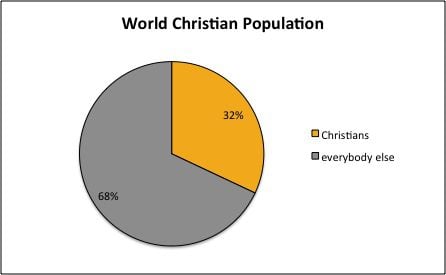When I was new to religious studies (or “comparative religion”), whenever I initially began the study of any particular religion, I always wondered, “How many of these guys are there, in the world? Is this a really big religion? A really small religion? A medium-sized religion? If it’s big, how big? If it’s small, how small?”
In previous blog entries, I have posted both a global religious pie chart (which graphically displays the various sizes of the world’s religions, relative to each other), as well as a similarly formatted U.S. religious pie chart (which shows the relative sizes of the majority faiths found within the United States alone).
However, none of the major world religions is “homogenous,” in the sense of being exactly the same everywhere, through and through; none of them exists solely in one single, universal, monolithic, “pure” form or version. All of the major religions are characterized by internal schism and diversity, each containing multiple differing divisions and branches, essentially constituting different forms or versions of each religion, all existing alongside each other.
Each major world faith, in other words, subdivides into a number of subdivisions, subgroups, sects, or “denominations” (to use a term usually reserved for Protestant Christian sects and branches). Islam, for example, has its Sunni and Shi’a branches; Buddhism has its Theravada, Mahayana, and Vajrayana wings; Christianity splits broadly into Catholic, Orthodox, and Protestant divisions (with Protestantism itself further subdividing into numerous denominations and non-denominational groups); Judaism subdivides into its Orthodox, Conservative, and Reform movements; and so forth.
In other words, when looking at that global religious pie chart and seeing the Hindu, Buddhist, Jewish, Christian, and Muslim slices of that pie, one does not see that each of those major slices can be further subdivided into smaller slices. Each such smaller “sub-slice” would correspond to a subdivision, sect, branch, or denomination within that major slice (or within that major religion).
But how big are each of these “sub-slices,” relative to each other, within each major slice of the religious pie? And in what ways do these different “sub-slices” within each major pie slice actually differ from each other? (The various sub-slices of the Christian portion of the pie still all “taste like” Christianity, for instance, yet each such sub-slice nevertheless also has a distinctive variant flavor all its own.)
In a previous blog entry, I have already presented some statistics and some graphic “pie charts” to illustrate the religious demographics and denominational affiliations found within Judaism. There, pie charts can be found which break down Judaism into its various branches and movements, graphically displaying the relative sizes of each of these internal Jewish subdivisions, and providing a thumbnail sketch of how these branches differ from each other.
Having already covered Judaism, in my next few blog entries I’d like to round out the big picture, by taking a closer look at each of the other major religions of the world in the same sort of way. One by one, we’ll look at some of the subdivisions that can be found within Hinduism, Buddhism, Christianity, and Islam. We’ll identify their major branches or denominations, touch briefly upon what distinguishes one such branch from the other, and also get a sense of how large or small each such major subdivision within each religion actually is.

